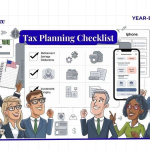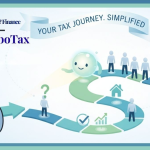Paying your first income tax is a big step for any citizen. It might seem hard and confusing if you’re new to it. But don’t worry, this article will make it easy to understand the basic income tax for beginners.
The tax year in India starts on April 1st and ends on March 31st of the next year. This means your tax year closes on March 31st and a new one begins on April 1st. So, it’s key to plan your taxes for each financial year. The year after the previous one is when you file your tax return. For example, the assessment year is 2023-24 for the 2022-23 year.
Also Read: How to Fix Defective Tax Returns: Ultimate Guide About Section 139(9)
When you start working, talk to your payroll or HR team. They can give you your salary details or tax statement. This will show you how much tax will be taken from your pay.

Basic Income Tax Key Takeaways
- Income tax is a mandatory payment made to the government based on your earnings.
- The financial year in India runs from April 1st to March 31st.
- The assessment year is after the financial year, in which you file your tax return.
- Tax rates vary under the new and old tax regimes, ranging from 5% to 30%1.
- Individuals earning below Rs. 2,50,000 in a financial year are exempt from paying taxes1.
Understanding Basic Income Tax in India
Income tax is a key part of India’s tax system. The central government collects it from people’s and businesses’ earnings each year. This money helps pay for things like roads, health care, schools, and support for farmers and the poor.
What is Income Tax?
The Income Tax is a direct tax, which is a mandatory financial burden imposed by the government on what people and businesses make. The Income Tax Act of 1961 says everyone in India who makes money must file tax returns.
Also Read: Big Update: New TDS Changes on Salary in Budget 2024
Types of Taxpayers
There are many types of taxpayers in India, like individuals and companies. People living in India pay tax on all their income. But people living outside India only pay tax on money made in India2. Whether someone is seen as living in India depends on how long they stay each year.
If you make more than ₹2.5 lakh a year, you must pay income tax in India. There are different groups of taxpayers, like the young and the old, and businesses. The tax rules change based on where you live and how much you make.
| Taxpayer Category | Taxable Income Threshold |
|---|---|
| Individuals under 60 years | Above ₹2.5 lakh |
| Individuals between 60 and 80 years | Above ₹3 lakh |
| Individuals aged over 80 years | Above ₹5 lakh |
The Income Tax Act of 1961 sets the rules for income tax in India. It has sections like Section 80C for deductions, helping people pay less tax.
People must file tax returns every year under the Income Tax Act. If you’re late, you might have to pay extra fees. There are different forms for different kinds of income and jobs in India.
“Understanding income tax in India is key for everyone to follow the law, save on taxes, and help the country grow.”
Heads of Basic Income Tax and Tax Rates
In India, income tax comes from five main sources Salary, House Property, Business or Profession, Capital Gains, and Other sources. Each source has its own rules for calculating taxes.
Income from Salary lets you claim things like House Rent Allowance and Transport Allowance. Income from House Property can be self-occupied, Let out, or Deemed Let out, with different rules.
Profits and Gains from Business or Profession includes many types of business income. Income from Capital Gains has different tax rates for short-term and long-term gains4. Income from Other Sources includes things like dividends and rent.
Tax Slabs and Rates
Tax rates in India depend on your income level. The old tax system had three rates: 5%, 20%, and 30%. You could use the old system and claim deductions for things like investments and home loans.
The 2020 budget introduced a new tax system with lower rates and fewer deductions. This new system has seven income levels with rates from 0% to 30%5. Most deductions and exemptions are not allowed under this system.
Income tax slabs for Everyone under the new tax regime
| Income tax slabs (Rs) | Income tax rate (%) |
| From 0 to 3,00,000 | NIL |
| From 3,00,001 to 7,00,000 | 5% |
| From 7,00,001 to 10,00,000 | 10% |
| From 10,00,001 to 12,00,000 | 15% |
| From 12,00,001 to 15,00,000 | 20% |
| From 15,00,001 and above | 30% |
| Income tax slabs for individuals under old tax regime | |
| Income tax slabs (Rs) | Income tax rates (%) |
| From 0 to 2,50,000 | 0 |
| From 2,50,001 to 5,00,000 | 5 |
| From 5,00,001 to 10,00,000 | 20 |
| From 10,00,001 and above | 30 |
| Income tax slabs for senior citizens under old tax regime | |
| Income tax slabs (Rs) | Income tax rates (%) |
| From 0 to 3,00,000 | 0 |
| From 3,0,001 to 5,00,000 | 5 |
| From 5,00,001 to 10,00,000 | 20 |
| From 10,00,001 and above | 30 |
| Income tax slabs for super senior citizens under old tax regime | |
| Income tax slabs (Rs) | Income tax rates (%) |
| From 0 to 5,00,000 | 0 |
| From 5,00,001 to 10,00,000 | 20 |
| From 10,00,001 and above | 30 |
The new tax system has lower rates but fewer deductions. You can choose between the old and new systems based on what works best for you.
Basic Income Tax India
Income tax is key to India’s tax system, bringing in a lot of money for the government. The Income Tax Act, of 1961, and the Finance Acts each year, set the rules for income tax. People in India, like individuals, businesses, and others, must file tax returns and pay taxes on what they earn.
To file taxes, you need to know the different types of income, figure out your taxable income, and claim deductions and exemptions you can get. The Income Tax Department helps by giving guidelines and making sure people follow the rules. It’s important to keep up with changes in tax laws to meet your tax duties and save on taxes.
Also Read: Why You NEED to Submit Form 15G and Form 15H for Income Taxes
Residential Status of India as per Income Tax Act.
To be seen as living in India for tax, you must spend 182 days or more here in a year. But, the Finance Act of 2020 changed this. Now, if you’re an Indian citizen or have Indian roots and spend over 120 days here, earn more than ₹15 lakh, and don’t get income from abroad, you’re considered a resident from 2021-22.
People living in India have different tax rules based on where they live: Residents and Ordinarily Resident pay taxes on all income, Residents but Not Ordinarily Resident pay on income made in India, and non-residents pay on income they get in India. The tax rates under the Alternate Personal Tax Regime (APTR) changed on 1 April 2023. People under APTR don’t get some exemptions and deductions.
Residential Status and Tax Obligations
| Residential Status | Tax Obligations |
|---|---|
| Resident and Ordinarily Resident (ROR) | Taxed on worldwide income |
| Resident but Not Ordinarily Resident (RNOR) | Taxed on income arising in India |
| Non-Resident (NR) | Taxed on income received in India |
Before, different tax rates applied to people based on their income for the 2022/23 tax year. A surcharge was added if your total income was over INR 5 million, with higher rates for higher incomes. Then, a 4% health and education cess was added to the tax and surcharge to get the final tax.

People living in India might get tax rebates based on their income and tax regime. COVID-19 relief gave tax breaks for medical and COVID-19-related payments8. Also, the Alternative Minimum Tax (AMT) affects those with business or professional income, and it’s based on adjusted total income.
The Income Tax Department offers many resources to help with taxes:
- 100% of the tax return forms you need
- Clear tax rates and slabs
- Info on deductions and exemptions
- Help with updating your details
- Easy filing options
- Forms, manuals, and FAQs you can download
- Videos to learn from
- Tax calculators to estimate your taxes
- FAQs specific to filing taxes
- Steps for verifying your taxes online
- How to request services and find more help
- Checking for tax credit issues
- Help on social media too
Knowing the latest about income tax helps people and businesses in India manage their taxes better, claim deductions, and follow the law. The Income Tax Department’s resources make filing taxes easy and smooth for everyone in the country.
“Taxation is the price we pay for a civilized society.” – Oliver Wendell Holmes Jr.
Conclusion on Basic Income Tax
Learning about India is key for everyone, from new workers to long-time filers. This article covered the main parts of income tax. It talked about what income tax is, who pays it, and how it’s split up. It also explained the tax rates and the old and new tax rules.
Knowing these things helps people follow the laws. They can then claim deductions and exemptions. This way, they can save more on taxes. Keeping up with changes helps people plan their money better and make smart choices.
The9 is a big deal in India, making up over half of the government’s money. It’s what the government uses for things like schools and roads9. The9 covers many groups, like people, families, and companies.
It aims to make things more equal, grow the economy, keep things stable, and help with development9.
Understanding deductions and exemptions helps people save more on taxes. It’s also good for doing their civic duty. Keeping up with changes makes filing easier and helps with financial planning.
FAQs on Basic Income Tax
What is the previous year or financial year?
The previous year or financial year is 12 months. It starts on April 1 and ends on March 31 of the next year. It’s important to plan your taxes for each financial year.
What is the assessment year?
The assessment year is the year after the previous year for filing your tax return. For example, the assessment year 2023-24 is for the previous year 2022-23. This is the year you file your return for the previous year.
Who are the different types of taxpayers?
Everyone in India who earns taxable income must file income tax returns. The Income Tax Act classifies taxpayers into different groups. These include Individuals, Hindu Undivided Families (HUF), Firms, Companies, and more.
How is Basic Income Tax calculated?
Income tax is based on your income and the tax slab you’re in. The old tax regime had three rates: 5%, 20%, and 30%. A new tax regime was introduced in 2020 with lower rates and fewer deductions.
What are the different heads of income?
Income is divided into five main categories for easier tracking. These include Salary, House Property, Business and Profession, Capital Gains, and Other Sources.
What is the importance of understanding income tax in India?
Knowing about basic income tax in India is crucial for everyone. It helps you follow the laws, claim deductions, and save on taxes.
Source Links
- https://cleartax.in/s/income-tax-basics-for-beginners
- https://www.iciciprulife.com/insurance-library/income-tax.html
- https://groww.in/p/tax/income-tax
- https://cleartax.in/s/5-heads-of-income-tax
- https://www.incometax.gov.in/iec/foportal/help/individual/return-applicable-1
- https://www.incometax.gov.in/iec/foportal/help/all-topics/e-filing-services/filing-your-return
- https://www.incometax.gov.in/iec/foportal/help/individual/return-applicable-0
- https://taxsummaries.pwc.com/india/individual/taxes-on-personal-income
- https://blog.ipleaders.in/income-tax-act-1961-a-comprehensive-overview/
- https://paytm.com/blog/income-tax/income-tax-act-1961/
Thank you for reading this post, don't forget to subscribe!






